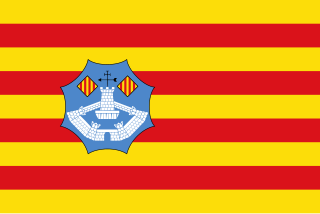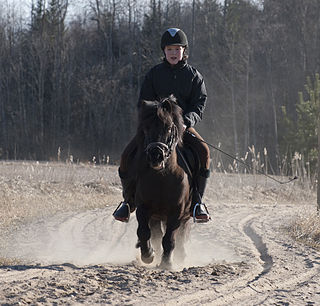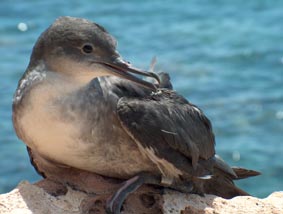Related Research Articles

The horse is a domesticated, one-toed, hoofed mammal. It belongs to the taxonomic family Equidae and is one of two extant subspecies of Equus ferus. The horse has evolved over the past 45 to 55 million years from a small multi-toed creature, close to Eohippus, into the large, single-toed animal of today. Humans began domesticating horses around 4000 BCE, and their domestication is believed to have been widespread by 3000 BCE. Horses in the subspecies caballus are domesticated, although some domesticated populations live in the wild as feral horses. These feral populations are not true wild horses, which are horses that never have been domesticated and historically linked to the megafauna category of species. There is an extensive, specialized vocabulary used to describe equine-related concepts, covering everything from anatomy to life stages, size, colors, markings, breeds, locomotion, and behavior.

Menorca or Minorca is one of the Balearic Islands located in the Mediterranean Sea belonging to Spain. Its name derives from its size, contrasting it with nearby Mallorca. Its capital is Mahón, situated on the island's eastern end, although Menorca is not a province and forms a political union with the other islands in the archipelago. Ciutadella and Mahón are the main ports and largest towns. The port of Mahón is the second biggest natural port in the world.

The Shetland pony is a Scottish breed of pony originating in the Shetland Islands in the north of Scotland. It may stand up to 107 cm (42 in) at the withers. It has a heavy coat and short legs, is strong for its size, and is used for riding, driving, and pack purposes.

The Balearic shearwater is a medium-sized shearwater in the seabird family Procellariidae. Puffinus is a Neo-Latin loanword based on the English "puffin" and its variants, that referred to the cured carcass of the fat nestling of the Manx shearwater, a former delicacy. The specific mauretanicus refers to Mauretania, an old name for an area of North Africa roughly corresponding to Morocco and Algeria. The Balearic Shearwater is listed critically endangered by the IUCN and is one of Europe's most endangered seabirds.

The Icelandic horse is a breed of horse developed in Iceland. Although the horses are small, at times pony-sized, most registries for the Icelandic refer to it as a horse. Icelandic horses are long-lived and hardy. In their native country they have few diseases; Icelandic law prevents horses from being imported into the country and exported animals are not allowed to return. In addition to the gaits of walk, trot, and canter/gallop typical of other horse breeds, many Icelandic horses can also do the tölt and the flying pace. The only breed of horse in Iceland, they are also popular internationally, and sizable populations exist in Europe and North America. The breed is still used for traditional sheepherding work in its native country, as well as for leisure, showing, and racing.

Colonial Spanish horse is a term for a group of horse breed and feral populations descended from the original Iberian horse stock brought from Spain to the Americas. The ancestral type from which these horses descend was a product of the horse populations that blended between the Iberian horse and the North African Barb. The term encompasses many strains or breeds now found primarily in North America. The status of the Colonial Spanish horse is considered threatened overall with seven individual strains specifically identified. The horses are registered by several entities.

The Mallorquín or Caballo Mallorquín is a rare breed of horse indigenous to the island of Mallorca in the Balearic Islands, from which it takes its name. Identification of the breed was begun in 1981 by the Patronato para las Razas Autóctonas de Mallorca. The Mallorquín is listed in the Catálogo Oficial de Razas de Ganado de España in the group of autochthonous breeds in danger of extinction.
Balearic may refer to:

A pony is a type of small horse. Depending on the context, a pony may be a horse that is under a given height at the withers, or a small horse with a specific conformation and temperament. Compared to a larger horse, a pony may have a thicker coat, mane and tail, with proportionally shorter legs, a wider barrel, heavier bone, a thicker neck and a shorter, broader head. The word pony derives from the old French poulenet, meaning foal, a young, immature horse.

The Balearic Islands are an archipelago in the western Mediterranean Sea, near the eastern coast of the Iberian Peninsula. The archipelago conforms a province and autonomous community of Spain, with Palma de Mallorca being its capital and largest city.

The Menorquín or Catalan: Cavall Menorquí is a breed of horse indigenous to the island of Menorca in the Balearic Islands, from which it takes its name. It is closely associated with the doma menorquina style of riding.

The Balearic, Catalan: Ase Balear, Spanish: Asno Balear, is a Spanish breed of domestic donkey indigenous to the autonomous community of the Balearic Islands, in the Mediterranean off the eastern coast of Spain. It is found mainly in Mallorca, the largest island of the group, and also in Menorca, where it was much used for mule-breeding; it is no longer present in the islands of Eivissa and Formentera. Since 2006 it has been officially called the Raça Asenca Balear; it was previously known as the Raça Asenca Mallorquina, and was also referred to as the Ase MallorquÍ, Asno Mallorquín or Mallorquín.

Horses have been an important component of American life and culture since before the founding of the nation. In 2008, there were an estimated 9.2 million horses in the United States, with 4.6 million citizens involved in businesses related to horses. There are an estimated 82,000 feral horses that roam freely in the wild in certain parts of the country, mostly in the Western United States.

The Ca Rater Mallorquí or Spanish: Ratonero mallorquín is a Spanish breed of dog of ratter type, found on the island of Mallorca in the Balearic Islands.

The Ca Mè Mallorquí is a Spanish breed of pointing dog originating in the Mediterranean island of Mallorca, in the Balearic Islands. It was traditionally used as a pointing dog in hunting. It was officially recognised by the national government of Spain in 2004, but is not recognised by either the Fédération Cynologique Internationale or the Real Sociedad Canina de España.

Formentera is one of the four constituencies represented in the Parliament of the Balearic Islands, the regional legislature of the Autonomous Community of the Balearic Islands. The constituency currently elects one deputy using plurality voting. Its boundaries correspond to those of the island of Formentera.

Ibiza is one of the four constituencies represented in the Parliament of the Balearic Islands, the regional legislature of the Autonomous Community of the Balearic Islands. The constituency currently elects 12 deputies. Its boundaries correspond to those of the island of Ibiza. The electoral system uses the D'Hondt method and a closed-list proportional representation, with a minimum threshold of five percent.

Mallorca is one of the four constituencies represented in the Parliament of the Balearic Islands, the regional legislature of the Autonomous Community of the Balearic Islands. The constituency currently elects 33 deputies. Its boundaries correspond to those of the island of Mallorca. The electoral system uses the D'Hondt method and a closed-list proportional representation, with a minimum threshold of five percent.

The Spanish Trotter, Spanish: Trotador Español, is the national breed of trotting horse of Spain. It is reared almost exclusively in the Balearic Islands in the Mediterranean, predominantly in the island of Mallorca, but also in Menorca and Ibiza.
References
- ↑ Lydekker, Richard. The horse and its relatives - Page 137-138
- ↑ Bauer, Mary Ellen. Which Horse of Course p. 61
- ↑ Walker, Stella A. Summerhays' Encyclopaedia for horsemen, p. 23 (1975)
- ↑ Sliver, Caroline. Guide to the Horses of the World, Chartwell Books, 1991 and Illustrated Guide to Horses of the World, Longmeadow Press, 1993 appear to be the same book, p. 102
- ↑ Nendricks, Bonnie L and Anthony A. Dent. International Encyclopedia of Horse Breeds, p. 60